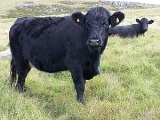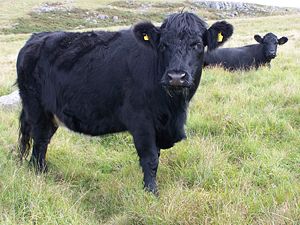
Welsh Black
Encyclopedia

Breed
A breed is a group of domestic animals or plants with a homogeneous appearance, behavior, and other characteristics that distinguish it from other animals or plants of the same species. Despite the centrality of the idea of "breeds" to animal husbandry, there is no scientifically accepted...
of cattle
Cattle
Cattle are the most common type of large domesticated ungulates. They are a prominent modern member of the subfamily Bovinae, are the most widespread species of the genus Bos, and are most commonly classified collectively as Bos primigenius...
native to Wales
Wales
Wales is a country that is part of the United Kingdom and the island of Great Britain, bordered by England to its east and the Atlantic Ocean and Irish Sea to its west. It has a population of three million, and a total area of 20,779 km²...
.
History
Commercial exploitation of the breed meant that droversDroving
Droving is the practice of moving livestock over large distances by walking them "on the hoof".Droving stock to market, usually on foot and often with the aid of dogs, has a very long history in the old world...
would herd them to English markets. Herds from south west Wales travelled towards Hereford
Hereford
Hereford is a cathedral city, civil parish and county town of Herefordshire, England. It lies on the River Wye, approximately east of the border with Wales, southwest of Worcester, and northwest of Gloucester...
and Gloucester
Gloucester
Gloucester is a city, district and county town of Gloucestershire in the South West region of England. Gloucester lies close to the Welsh border, and on the River Severn, approximately north-east of Bristol, and south-southwest of Birmingham....
up the Tywi Valley to Llandovery
Llandovery
Llandovery is a market town in Carmarthenshire, Wales, lying on the River Tywi and the A40 road.The town is served by Llandovery railway station, where there is a park and ride to Llanelli and Shrewsbury via the Heart of Wales Line...
. Herds from South Cardiganshire reached Llandovery through Llanybydder
Llanybydder
Llanybydder is a market town straddling the River Teifi in Carmarthenshire and Ceredigion, West Wales, with a population of 1,423, almost three quarters of whom are Welsh-speaking according to the United Kingdom Census 2001. The nearest university is the University of Wales, Trinity Saint David,...
and Llansawel
Llansawel
Llansawel is a community located in Carmarthenshire, West Wales....
. They would then return to Wales with large amounts of money, which made them targets of bandits and highwaymen. The result was the formation in 1799 of the Banc yr Eidon
Llandovery Bank
The Llandovery Bank was established in Llandovery in 1799 in the premises known as the King’s Head on Stone Street , where it remained for many years...
in Llandovery, the Bank of the Black Ox, which was later purchased by Lloyds Bank
Lloyds Bank
Lloyds Bank Plc was a British retail bank which operated in England and Wales from 1765 until its merger into Lloyds TSB in 1995; it remains a registered company but is currently dormant. It expanded during the nineteenth and twentieth centuries and took over a number of smaller banking companies...
.
By the turn of the 19th century, 25,000 cattle were being exported from Wales every year. Before the 1960s, few cattle were exported outside the UK, but now can be found in Canada, New Zealand, Australia and Germany as well in countries such as Saudi Arabia, Jamaica and Uganda.
Characteristics
As the name suggests, the cattle are naturally black. They generally have white hornsHorn (anatomy)
A horn is a pointed projection of the skin on the head of various animals, consisting of a covering of horn surrounding a core of living bone. True horns are found mainly among the ruminant artiodactyls, in the families Antilocapridae and Bovidae...
with black tips, but these may be removed, and there are also naturally hornless (polled
Polled livestock
Polled livestock are livestock without horns, of species that normally have them. The term refers both to breeds or strains which are naturally polled through selective breeding and also to naturally horned animals which have been dehorned...
) strains. Red individuals occur occasionally – red and other colours were more common in the past.
Its hardy nature coupled with its habit of browsing
Browsing (predation)
Browsing is a type of herbivory in which an herbivore feeds on leaves, soft shoots, or fruits of high growing, generally woody, plants such as shrubs. This is contrasted with grazing, usually associated with animals feeding on grass or other low vegetation...
as well as grazing
Grazing
Grazing generally describes a type of feeding, in which a herbivore feeds on plants , and also on other multicellular autotrophs...
makes it ideal for rough pasture such as heathland and moorland, and for conservation grazing
Conservation grazing
Conservation grazing is the use of semi-feral or domesticated grazing livestock to maintain and increase the biodiversity of natural or semi-natural grasslands, heathlands, wood pasture, wetlands and many other habitats....
.
Traditionally bred for both milk
Milk
Milk is a white liquid produced by the mammary glands of mammals. It is the primary source of nutrition for young mammals before they are able to digest other types of food. Early-lactation milk contains colostrum, which carries the mother's antibodies to the baby and can reduce the risk of many...
and beef
Beef
Beef is the culinary name for meat from bovines, especially domestic cattle. Beef can be harvested from cows, bulls, heifers or steers. It is one of the principal meats used in the cuisine of the Middle East , Australia, Argentina, Brazil, Europe and the United States, and is also important in...
, commercially it is now usually used only for beef.
External links
- Welsh Black Cattle Society
- http://www.ansi.okstate.edu/breeds/cattle/welshblack/
- Welsh Black Bull bronze near the Royal Welsh showground in Llanelwedd / Builth Wells

